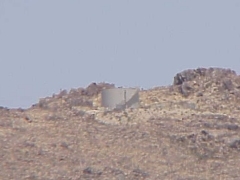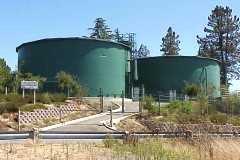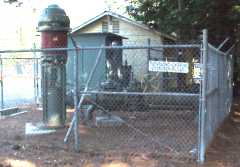© 2000 Capt. Willis Lamm, Water Supply Officer, Moraga-Orinda (CA) Fire DistrictBackground Criteria Storage Distribution Hyd. Design Placement Installation Codes & Markings Applications Codes & Standards
|
| STORAGE FACILITIES |
|
There are three principle components to the fire protection element of any water system; storage,
distribution and the hydrants themselves. While functional hydrants and a good water delivery
system are important, everything starts with proper storage.
Water for fire fighting should be provided by gravity storage wherever possible. Using elevation as the means for developing proper water pressure in water mains and hydrants is reliable, not dependent on pumps that could fail or be shut down as a result of an electrical outage. Storage can be provided through one or more large reservoirs or by multiple smaller reservoirs throughout the community that are linked together.
|
Typical reservoir tank on hillside
|
|
Elevation
In establishing a proper elevation for reservoirs, one can calculate that every foot of head will produce .434 p.s.i. of pressure. Therefore to generate 65 p.s.i. in the water distribution system, storage reservoirs must be located at an elevation of approximately 150 ft. above the service area. Adequate system pressures are generally accepted to be between 65 and 85 p.s.i. Accordingly, reservoirs should be placed at elevations between 150 and 200 ft. above service areas. Since most communities are not perfectly flat, there will be some variation in service pressure. While it may be possible to establish a reservoir level to most of a hilly community, it is often possible to design a system where the predominance of the community falls within the 65 - 85 p.s.i. range with pressures in some portions experiencing less desirable but acceptable ranges as low as 50 p.s.i. and as high as 120 p.s.i. In locations where pressure gradients may fall outside these less desirable pressure ranges, additional reservoirs should be set at appropriate elevations to serve these areas or main-line pressure regulators should be installed to protect low-lying areas from overpressurization.
| |
|
Reservoir Size
Most municipal water systems for fire fighting provide combination service for fire hydrants and domestic (private and commercial) use. Thus the determination for volume of water stored is based on a number of factors. Reservoirs should have adequate capacity to provide continuous domestic flow in the event of a disruption of the reservoir refilling system. They must also have adequate storage to provide anticipated fire flows for a reasonable duration.
|
Multiple tank reservoir
|
|
A reasonable rule of thumb is that storage should be sufficient to provide at least two days of peak
domestic consumption plus required fire flows as determined by the Fire Chief. For example, in
a typical residential neighborhood with no unusual hazards, storage based on a fire flow of 1,000 GPM (3785 L/min) for two hours
may be appropriate. In commercial, industrial or urban-wildland interface zones, flows on
the order of 5,000 GPM (19,000 L/min) for 3 hours may be required.
Reserve capacity may have to be balanced by water quality issues. There must be sufficient water changeover in reservoirs to keep water fresh and healthful. In communities where water use and fire risk are seasonal, multiple small reservoir tanks can be employed. During periods of peak use and fire risk, all the tanks can be used for storage. During low use / low danger periods, an appropriate number of tanks can be emptied and left "off-line." | |
|
Pumping Facilities
The primary role of pumping facilities should be to maintain appropriate levels in reservoirs. With adequately sized pumps and reservoirs, pumping can generally take place late at night and early morning when electricity demand is light. Pumps need to be protected from vandalism and appropriately reinforced for seismic stability. Automatic stand-by generators should be provided, or at minimum, an ability should be provided to rapidly connect a mobile generator in the event of a long term power failure. Connections should also be provided so that a portable pump can be installed in the event the pump itself fails. |
Typical pump plant with
|
|
The concepts illustrated here are intended to provide the viewer with a general overview of the issues involved with modern water storage. Specific requirements and technical details should be based on fire department and health department requirements, local engineering standards and a practical application of modern technology. | |
| Continue to Part 3 |
Return to Part 1
Return to Information Section
Return to Water Supply Page
Background Criteria Storage Distribution Hyd. Design Placement Installation Codes & Markings Applications Codes & Standards
|


